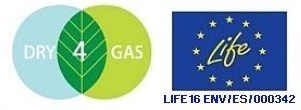The expected results of DRY4GAS project, in line with the objectives set, can be quantified according to the following parameters:
- Reduction of CO2 emissions between 880 and 1111 t/yr as a result of the use of renewable energy to carry out the drying process against the use of natural gas whose emissions are estimated as baseline at 242 t CO2/yr. Electricity generated in the gasification process without burning fossil fuels, and the reduction in transportation of wet sludge. The baseline considered is the emissions of 11 t CO2/yr produced currently by the 129 transportations per year of the sludge to be valorized in agriculture.
- Production of electrical and thermal energy of 320 and 640 MWh/year, respectively.
- Reduction between 67 and 83%, depending on the dryness of the sludge after the drying process, of wet sludge valorization in agriculture.
- Reduction of both acoustic emissions and odor nuisance, due to volatile compounds present in the sludge. This parameter undergoes a variable shrinkage between 53 and 72%, depending on the dryness level of the dried sludge.Este parámetro sufrirá una merma variable entre el 53 y el 72%, en función de la sequedad del lodo seco.
- The equivalent population affected while carrying out the project will be reduced between 67 and 83%, compared with the baseline status by reducing the negative environmental impacts associated with using sludge in agriculture.
- Reduction of 20% in the use of chemical fertilizers as well as water consumption and increased carbon sequestration in soil in the same proportion.
In addition to the proposed results, other environmental improvements expected are the following:
- Development of a DRY4GAS methodology that fosters green circular economy and can be replicated it in other European and international regions. This methodology will be backed up by relevant economic feasibility studies, cost-benefit analyses and ROI data.
- Development of a life cycle analysis of the system that will determine the phases, stages or processes that have a major effect on the system. Acting upon these hotspots will allow an improvement in the environmental impact of the system in a cost effective way. The indicators that have been identified will serve as a benchmark to quantify the improvements.
